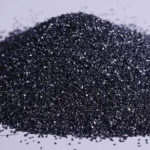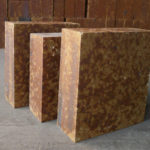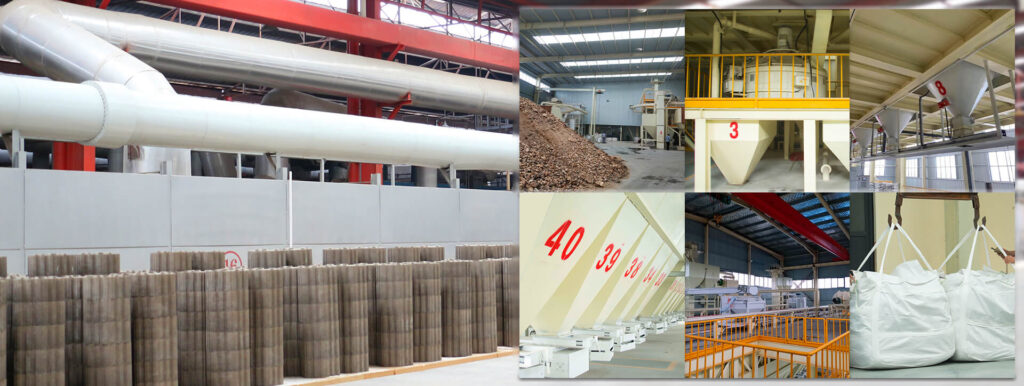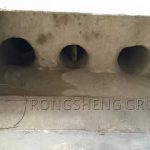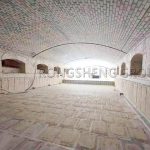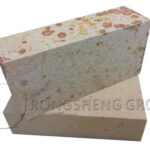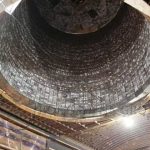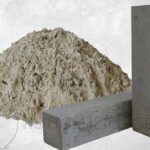Silicon carbide bricks have high thermal conductivity, good wear resistance, thermal shock resistance, and erosion resistance. Therefore, silicon carbide bricks are widely used in the industry. It is a refractory product made of silicon carbide as the main raw material. The silicon carbide content is 72% to 99%. Generally, black silicon carbide (with a SiC content of more than 96%) is used as the raw material, and a binder (or no binder) is added. The main crystal phase is silicon carbide. Next, Rongsheng refractory materials manufacturer will introduce their specific production process and performance according to the different bonding methods of silicon carbide bricks.
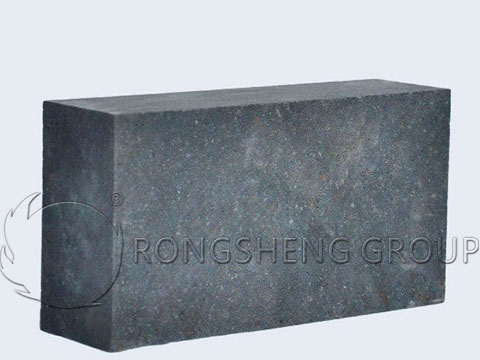
Silica Bonded Silicon Carbide Bricks
All products that are mainly composed of silicon carbide particles and fine powder, and part of silica and quartz fine powder as binders are all silicon carbide products combined with silicon dioxide.
For example, using 90% silicon carbide with different particle sizes and 5%-10% silica and calcium oxide mixture powder (less than 0.088mm), the mixing ratio is 8:2 or 9:1. After adding an appropriate amount of organic binder (pulp waste liquid, dextrin, methylcellulose) and mixing it into the mud, it is pressed and formed by a brick press, dried, and fired at 1300 ~ 1400 ℃. The physical properties of its products are shown in Table 1.
Table 1 Physical properties of silicon oxide bonded silicon carbide bricks
| Properties | Numerical Value |
| Bulk Density (g/cm3) | 2.14 |
| Apparent Porosity (%) | 24.8 |
| Cold Crushing Strength (MPa) | >70 |
| Refractoriness Under Load (℃) | >1600 |
| Thermal Conductivity ( W/(m·K) ) | 10.9 |
| Refractoriness (℃) | 1780 |
Clay Bonded Silicon Carbide Bricks
Clay bonded silicon carbide products are refractory products fired with silicon carbide as the main raw material and clay as the binder. The product has high thermal conductivity, good thermal shock resistance, and wear resistance. Used as lining bricks for aluminum refining furnaces, distillation tanks for zinc distillation furnaces, and cement kiln coolers.
Table 2 Physical and chemical properties of clay-bonded silicon carbide bricks
| Properties | Addition of Fireclay % | |||
| 3 | 3 | 10 | 20 | |
| SiC % | 88.4 ~ 90.6 | 80 ~ 84 | 7 ~ 86 | 73 ~ 75 |
| Apparent Porosity (%) | 24 ~ 26 | 20 ~ 25 | 15 ~ 21 | 21 ~ 31 |
| Cold Crushing Strength (MPa) | 48 ~ 62 | 30 ~ 50 | 40 ~ 100 | 120 |
| Thermal Conductivity ( W/(m·K) ) | (500℃)
7.2 ~ 9.86 |
– | (800℃)
8.35 ~ 9.86 |
4.64 |
| Refractoriness Under Load (℃) | 1380 ~ 1530 | 1530 ~ 1560 | 1680 ~ 1700 | 1680 |
High Alumina Bonded Silicon Carbide Bricks
(1) Production process. Using silicon carbide (SiC 98.32%) and mullite raw materials, mullite-bonded silicon carbide bricks are made. The particle size of silicon carbide sand is 8~5mm, 5~3mm, and 3~1mm. The mixed fine powder is made of silicon carbide powder and mullite powder, and the particle size of the fine powder is less than 0.044mm. After batching, the materials are mixed in a kneader and trapped for 24 hours, and then formed on a vibrating press molding machine. The green body is naturally dried for 15 days, dried at 30~35℃ for 15 days, and baked in a kiln at 200~350℃ for 6 days. The product is fired in an inverted flame kiln. The maximum firing temperature is 1500°C, the temperature is kept for 6 days, and the total firing time is 10 days.
(2) Physical and chemical properties. Physical and chemical properties of mullite-bonded silicon carbide bricks: SiO2 82%, mullite 15%, apparent porosity 17%~19%, bulk density 2.54g/cm3, load softening temperature greater than 1700 ℃, compressive strength greater than 110MPa, The thermal shock resistance (1100 ℃ water cooling) is more than 20 times. This large silicon carbide brick can be used for the tap hole of the ferroalloy electric furnace and ring brick of the blast furnace tuyere.
Nitride Bonded Silicon Carbide Bricks
-
Silicon nitride combined with silicon carbide bricks
(1) Raw materials. Add 30%~40% silicon carbide coarse sand, 30%~40% silicon carbide fine powder, and 20%~30% metal silicon powder to the ingredients.
(2) Ingredients. Mix the materials in a wet mill, first add silicon carbide powder and metal silicon powder and mix for 5~8min, add coarse sand and then mix for 10~20min. Add pulp waste liquid or molasses binder, wet mixing for 15~20min, and control the moisture at 4%±0.2%.
(3) Forming. Use a brick press to form, the forming pressure is 50MPa, or use an isostatic press or a pressurized vibration forming machine to form. Controlling the density of bricks at 2.5 g/cm3 is beneficial to nitriding.
(4) Dry. The moisture content of the brick after drying should be less than 0.5%, and it should be nitrided and fired in an electric furnace with nitrogen. The firing temperature is 1300~1350℃, and the temperature is kept for 5~10h.
Table 3 Standard of silicon nitride bonded silicon carbide bricks for blast furnace
| Items | Indicators | |
| DTZ-1 | DTZ-2 | |
| Apparent Porosity (%) ≥ | 17 | 19 |
| Bulk Density (g/cm3) ≥ | 2.62 | 2.58 |
| Cold Crushing Strength (MPa) ≥ | 150 | 147 |
| High-Temperature Flexural Strength 1400℃ (MPa) ≥ | 43.0 | 39.2 |
| SiC (%) ≥ | 72 | 70 |
| Si3N4 (%) ≥ | 21 | 20 |
| Fe2O3 (%) ≤ | 1.5 | 2.0 |
-
Sialon combined with silicon carbide bricks
Sialon bonded silicon carbide bricks mainly use silicon carbide, Sialon, and sintering agent as raw materials. Its ingredient composition is shown in Table 4. After being pressed and formed, it was fired in a nitrogen medium at temperatures of 1450°C, 1500°C, and 1550°C for 4 hours.
Table 4 The ingredient composition (%) of Sialon-bonded silicon carbide refractories
| NO. | SiC | Sialon | Additive |
| 1 | 60 | 34 | 6(2% MgO + 4% Rare earth element oxide) |
| 2 | 50 | 42 | 8(3% MgO + 5% Rare earth element oxide) |
| 3 | 70 | 25.5 | 4.5(1.5% MgO + 3% Rare earth element oxide) |
| 4 | 60 | 34 | 6(2% MgO + 4% Al2O3) |
| 5 | 50 | 42 | 8(3% MgO + 5% Al2O3) |
| 6 | 70 | 25.5 | 4.5(1.5% MgO + 3% Al2O3) |
Self-bonding Silicon Carbide Bricks
Self-bonding (reactive bonding) silicon carbide bricks are products made of silicon carbide as a bonding phase. In production, silicon carbide particles are used as aggregate, silicon carbide powder, metal silicon powder, and carbon powder are used as matrix, and tar pitch is used as the binder. After hot kneading, it is molded on a hot press and fired under protective conditions. The performance comparison with other combined silicon carbide bricks is shown in Table 5.
Table 5 Properties and Comparison of Self-bonded Silicon Carbide Products
| Items | Silicate Binding | Silicon Nitride Bonding | Silicon Oxynitride Bonding | Self Binding | |
| SiC (%) | 86 | 75 | 86 | 90 | |
| Bulk Density (g/cm3) | 2.50 | 2.60 | 2.54 | 2.58 | |
| Apparent Porosity (%) | 20 | 15 | 19 | 16 | |
| Bending Strength(MPa) | 20℃ | 20 | 40 | 35 | 35 |
| 1400℃ | 15 | 44 | 28 | 40 | |
| Thermal Conductivity ( W/(m·K) ) | 11 | 16 | 13 | 17 | |
| Thermal Shock Resistance, Intensity change after 5 hot and cold cycles | -16 | -28 | 0 | 0 | |
| Antioxidant Properties, Weight gain after heating in air at 1300 ℃ for 20 hours | 0.25 | 0.79 | 28 | 0.42 | |
| Erosion Resistance, High-temperature flexural strength before and after erosion | Before alkali
erosion |
15 | 44 | 35 | 40 |
| After alkali
erosion |
6 | 36 | 36 | ||

